Next Lesson - Bones of the Foot
Core
The lower limb is composed of many bones, which provide structural support and allow for attachment of muscles. In this chapter we shall discuss four of these bones:
- Femur
- Patella
- Tibia
- Fibula
The femur is the only bone that is present in the thigh, and it is the longest bone in the body! It is vital in providing sites of attachment for key muscles of the thigh and therefore aiding movement. It is also on of the strongest bones in the body, meaning that significant force is needed to cause trauma to the bone.
Some key PROXIMAL landmarks of the femur include:
- The Head of Femur – a smooth surface that is covered with articular cartilage. It articulates with the acetabulum of the pelvis to form the hip joint.
- The Neck of Femur – a cylindrical projection that allows for movement of the shaft via the hip joint. If fractured, it can lead to damage of the medial femoral circumflex artery – leading to avascular necrosis of the femoral head.
- Greater Trochanter – the most lateral projection of the femur. It is a key site of attachment for multiple muscles (e.g. gluteus medius and minimus). This is the easiest part of the proxima femur to palpate - it is the bony lump that is located laterally on the hip.
- Lesser Trochanter – a smaller projection of the femur, found more medially. It is the key site of attachment for the iliopsoas.
- Intertrochanteric Line – a prominent ridge that passes along the anterior surface of the femur between the two trochanters. This is the site of attachment for the hip joint capsule (anteriorly).
- Intertrochanteric Crest – a prominent ridge that passes between the two trochanters posteriorly.
On the shaft of the femur, there are three key bony landmarks. These act as sites of attachment for key muscles of the thigh:
- Pectineal Line – found medially on the posterior surface of the femoral shaft, and extends distally to become the medial aspect of the linea aspera.
- Gluteal Tuberosity – found laterally on the posterior surface of the femoral shaft, and extends distally to become the lateral aspect of the linea aspera.
- Linea Aspera – found on the posterior aspect of the shaft. Moving inferiorly, it branches to form the medial and lateral supracondylar lines.
Distally, the femur articulates with the tibia and patella to form the knee joint. There are a few key landmarks to know:
- Medial and Lateral Condyles – articulate with the tibia and patella to form the knee joint. They are covered in articular cartilage.
- Medial and Lateral Epicondyles – found superior to the condyles and act as attachment for the medial and lateral collateral ligaments, which stabilise the knee joint.
- Intercondylar Fossa – a region found on the posterior aspect of the femur, between the two condyles.
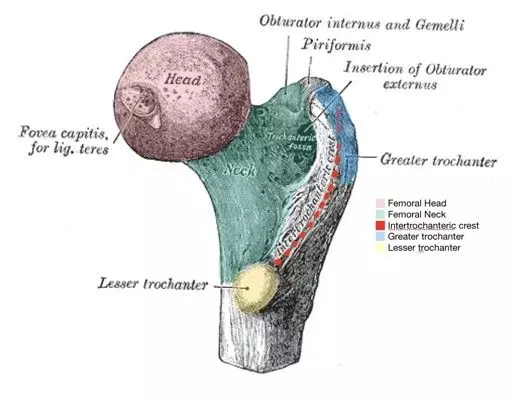
Diagram - Posterior aspect of the proximal femur
Creative commons source by Henry Gray Anatomy of the Human Body (1918), edited by Sachin Sudhakaran [CC BY-SA 4.0 (https://creativecommons.org/licenses/by-sa/4.0)]
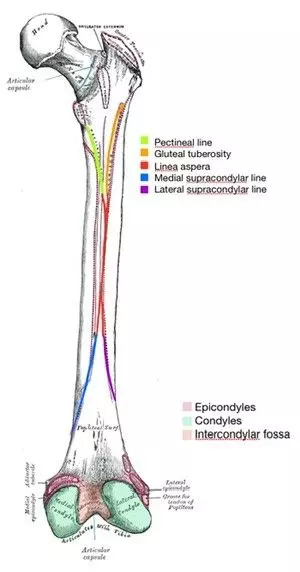
Diagram - Posterior aspect of the femur
Creative commons source by Henry Gray Anatomy of the Human Body (1918), edited by Sachin Sudhakaran [CC BY-SA 4.0 (https://creativecommons.org/licenses/by-sa/4.0)]
The patella is a sesamoid bone that is located anterior to the knee joint. It protects the anterior knee and aids hip extension by increasing leverage of the quadriceps tendon.
There are two important landmarks found on the posterior surface of the patella:
- Medial Facet – articulates with the medial condyle of the femur to aid movement.
- Lateral Facet – articulates with the lateral condyle of the femur to aid movement.
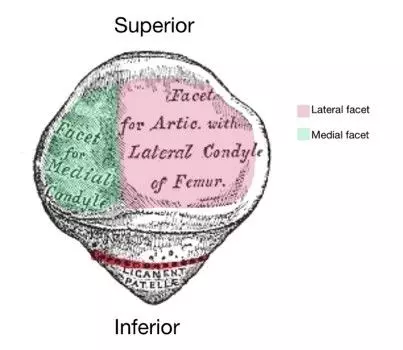
Diagram - Posterior aspect of the right patella. The most superior aspect of the patella is the ‘base’ whilst the most inferior aspect is called the ‘apex’
Creative commons source by Henry Gray Anatomy of the Human Body (1918), edited by Sachin Sudhakaran [CC BY-SA 4.0 (https://creativecommons.org/licenses/by-sa/4.0)]
The tibia (commonly known as the shin bone) is the largest bone in the lower leg. It is built specifically to bear weight, hence the ‘flared’ proximal and distal ends.
Proximally, there are a few key landmarks:
- Medial and Lateral Condyles – form a flat surface called the Tibial Plateau. This articulates with the femoral condyles to aid movement of the knee joint.
- Tibial Tuberosity – located on the anterior surface of the tibia. Site of attachment for the patella ligament.
The main body of the tibia is prism-shaped and has an anterior, posterior and lateral surface. The anterior surface can be felt as the shin. The posterior surface is indicated by the soleal line, a site of attachment for the soleus muscle. The lateral border of the tibia provides a site of attachment for the interosseous membrane, which connects the tibia and fibula.
Distally, there are two important landmarks:
- Medial Malleolus – a projection on the medial aspect of the tibia. This forms part of the ankle joint with the tarsal bones of the foot.
- Fibular Notch – an important site of attachment between the fibula and tibia.
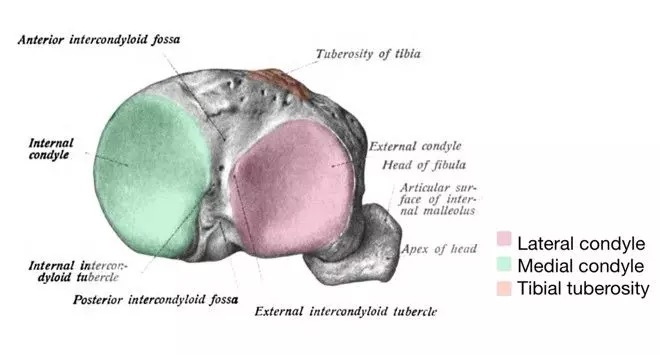
Diagram - Superior view of the tibial plateau of the right tibia
Creative commons source by Dr. Johannes Sobotta, edited by Sachin Sudhakaran [CC BY-SA 4.0 (https://creativecommons.org/licenses/by-sa/4.0)]
The fibula is located laterally to the tibia and acts as an attachment for muscles. The shaft of the tibia splits the leg into the three muscle compartments (anterior, posterior and lateral).
There are two important bony landmarks to know:
- Head of Fibula – articulates with the lateral condyle of the tibia.
- Lateral Malleolus – prominence that articulates with the talus bone of the foot to form the ankle joint. It is more prominent than the medial malleolus and is liable to fractures.
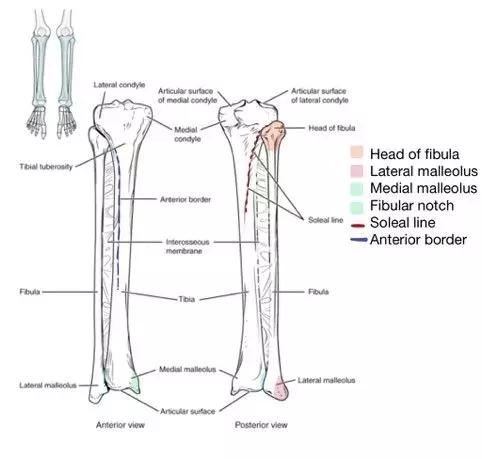 Diagram - Anterior and Posterior view of the right tibia and fibula. Notice the interosseous membrane connecting the two bones
Diagram - Anterior and Posterior view of the right tibia and fibula. Notice the interosseous membrane connecting the two bones
Creative commons source by OpenStax College, edited by Sachin Sudhakaran [CC BY-SA 4.0 (https://creativecommons.org/licenses/by-sa/4.0)]
For Pathologies and Conditions of the Lower Limb, check out our articles on Conditions of the Foot, Ankle, Lower Leg, Knee and Thigh.
Reviewed by: Dr. Thomas Burnell and Dr. Marcus Judge
Edited by: Dr. Maddie Swannack
- 14298

